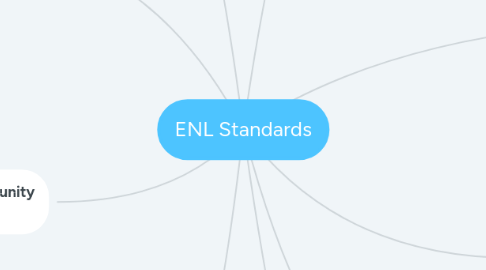ENL Standards
by Kayla Valachovic


1. I. Knowledge of Students
1.1. understand students
1.2. build relationships
1.3. aware of differences and challenges
1.4. draw on students' knowledge, experiences, and strengths
2. II. Knowledge of Culture & Diversity
2.1. learn, understand, and respect cultures
2.2. demonstrate sensitivity
2.3. honor cultural differences (holidays, etc.) and identities
2.4. instruct appropriate cultural behaviors for success in school
2.5. advocate for students
3. III. Home, School & Community Connections
3.1. build open communication with families
3.1.1. fosters success, indentifies concerns, and enables teachers to respond thoughtfully to families' interests
3.2. form partnership/team with parents
3.3. enable families to feel welcome, safe, and important in the school community
3.4. connect families to communitiy resources, services, and agencies
4. IV. Knowledge of English Learners
4.1. deep knowledge of domains of language
4.1.1. listening
4.1.2. speaking
4.1.3. reading
4.1.4. writing
4.1.5. visual literacy
4.2. strong knowledge of components of language
4.2.1. phonology
4.2.2. vocabulary
4.2.3. grammar
4.2.4. discours
5. V. Knowledge of English Acquisition
5.1. evaluate ways to expose students to meaningful language
5.2. meaningful interactions improve language development
5.3. integrate all domains to accelerate and reinforce language development
5.3.1. listening
5.3.2. speaking
5.3.3. reading
5.3.4. writing
5.3.5. visual literacy
5.4. provide constructive feedback
5.5. reflect on student needs to design curriculum
6. VI. Instructional Practice
6.1. analyze students' strengths and needs to design effective instruction
6.2. instruction is built upon students' backgrounds, personal experiences, strengths, interests, and linguistic abilities
6.3. use resources, families, and communities members as part of instruction
6.4. create a positive learning environment
6.5. provide various levels of differentiation
6.6. use students' primary languages as an effective learning tool
7. VII. Assessment
7.1. use a variety of assessment techniques
7.2. assess to pre-determine and place ELL student in appropriate academic setting
7.3. provide clear, timely, constructive feedback to students
7.4. use assessments to drive instruction and set goals for students
8. VIII. Teacher as Learner
8.1. engage in professional development
8.1.1. continue to learn about students' cultures, lanugages, and communities
8.1.2. stay abreast of current research and instructional methods

